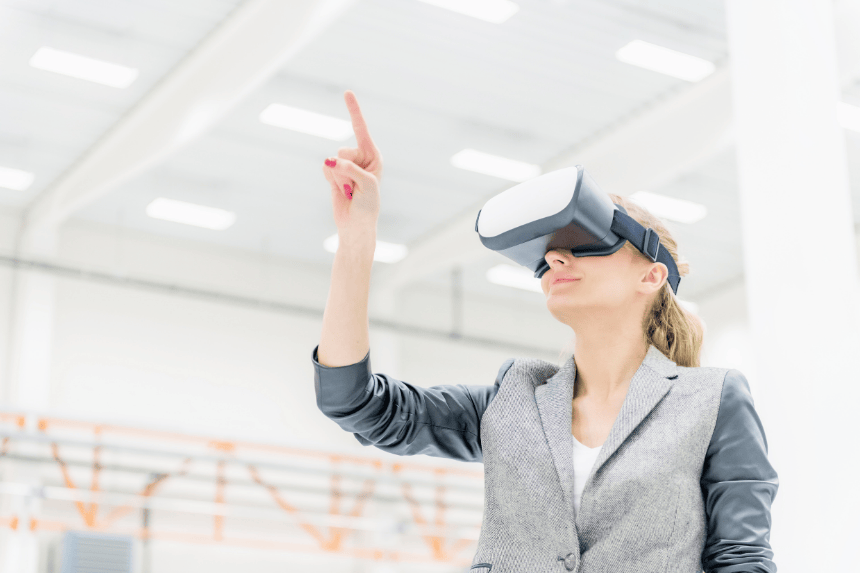
For the first time, a technician stands in front of a complex machine, not with a trainer hovering nearby or a manual in hand, but with augmented instructions guiding every move through their smart glasses.
There is no second-guessing involved or no backtracking, only real-time learning embedded in the task itself. That’s not a glimpse into the future. That’s training in 2025.
In a landscape where agility matters more than checklists, augmented reality (AR) is emerging as more than a buzzword; it’s becoming a business advantage. From slashing onboarding time to shrinking error rates, AR is reshaping how employees learn, practice, and perform on the job.
This article breaks down how AR is transforming the training industry, where it fits best, and what real-world benefits it delivers, from better retention to measurable ROI. If you’re rethinking your L&D strategy this year, AR should already be on your radar.
Understanding How AR Powers Real-Time Learning
Augmented Reality (AR) enhances the training experience by overlaying digital guidance like 3D models, step-by-step prompts, and visual cues onto physical environments. What sets AR apart isn’t just the interactivity but its ability to turn everyday workspaces into learning environments.
Rather than pausing their work for scheduled training or recorded lessons, employees access guidance in real time as they perform tasks, whether at their desks, on-site, or during customer engagements.
Whether a nurse is following a critical-care protocol or a medical student exploring anatomy through interactive 3D models, AR delivers precise, real-time guidance right when and where it’s needed, enhancing both learning and performance on the job.
This seamless, in-context learning method closes the gap between knowledge and application. It minimizes downtime, reduces dependency on printed materials or supervision, and builds muscle memory through repetition within real scenarios.
The result?
Faster skill acquisition, more confident execution, and smoother onboarding all without interrupting the workday.
Key Benefits of AR-Based Training
Augmented reality isn’t just a trend in learning and development; it’s a practical solution to many of the challenges businesses face when training employees. From boosting engagement to accelerating skill development, here are the key benefits AR brings to the table:
1. Enhanced Comprehension and Retention
- Helps employees visualize complex processes or concepts in real time.
- Translates theory into practical understanding with interactive 3D models and scenarios, making learning more engaging.
2. Risk-Free Practice Environments
- Allows employees to practice tasks or procedures without real-world consequences.
- Especially valuable for high-risk industries like manufacturing, healthcare, and aviation.
- Builds confidence and reduces errors before applying skills in real-life situations.
3. Scalability Across Devices and Organizations
- Works on everyday devices like smartphones, tablets, and AR glasses.
- Enables standardized training across teams while offering localization options for diverse workforces.
4. Engagement Through Active Participation
- Turns passive learning into active, hands-on experiences.
- Keeps employees engaged by prompting movement, observation, and response, making learning more interactive.
- Reduces dropout rates, especially in remote or self-paced training programs.
5. Immediate Personalized Feedback
- Provides real-time visual or audio cues to guide employees as they learn.
- Instantly corrects mistakes and reinforces the correct methods, helping to solidify understanding.
The benefits don’t stop at immersive visuals or hands-on practice. When you combine AR with artificial intelligence, the training experience becomes even smarter.
Let’s look at how AI takes AR-powered learning to the next level through real-time personalization and performance tracking.
AI-Powered Feedback Loops and Adaptive Learning
A standout feature of AR training is the integration of artificial intelligence (AI), which powers personalized learning paths. AI tracks learner behavior in real-time, adjusting content and feedback based on individual performance. This ensures each employee receives the right level of challenge, whether they need more time to master a concept or are ready to move on faster.
With AI-powered feedback loops, employees benefit from immediate corrections and tailored instructions, allowing them to learn at their own pace. For businesses, the result is a more confident and capable workforce, while managers gain valuable insights into employee progress and areas for improvement.
By combining AI with AR, companies enhance training effectiveness and see a direct impact on performance and return on investment (ROI) as employees develop new skills faster and more efficiently.
All these benefits make AR a powerful tool for building a workforce that learns faster, performs better, and stays engaged throughout the training process.
Applications of AR Across Industries
Augmented Reality is gaining traction across sectors because it addresses real training challenges in a practical, scalable way. Below is an expanded look at how different industries are successfully implementing AR to boost learning outcomes and operational efficiency:
1. Corporate Training: Onboarding, Soft Skills, and Knowledge Transfer
For large organizations, onboarding new employees quickly and effectively is critical. AR streamlines this process by delivering guided, immersive modules that walk new hires through systems, procedures, and workplace environments—right on the job.
Beyond onboarding, AR is also being used to build soft skills like communication, conflict resolution, and customer service through scenario-based simulations.
Key Applications:
- Interactive Product Training: This will enable employees to explore 3D product models, understand specifications, and troubleshoot common issues without needing physical prototypes.
- Gamified Learning Experiences: Use branching simulations and real-world scenarios (e.g., customer service, sales objections) to build soft skills in an engaging, low-risk environment.
- AR-Based Orientation Walkthroughs: Offer guided facility tours, workstation overviews, and safety briefings that familiarize new hires with their environment from day one.
- Scenario-Based Soft Skills Simulations: Train employees in communication, negotiation, or leadership using immersive character-based scenarios with real-time decision-making.
- Compliance and Policy Training: Use interactive AR modules to walk employees through safety procedures, ethical situations, or HR policies, with instant feedback built in.
Benefits:
- Speeds up time-to-productivity
- Standardizes knowledge transfer across regions
- Increases engagement and retention through active learning
2. Technical Skills Development: Maintenance, Machinery, and Repairs
In industries like manufacturing, automotive, and logistics, AR transforms how employees approach complex tasks. Workers can receive real-time overlays that guide them step-by-step through diagnostics, repairs, and safety procedures—reducing dependency on manuals or supervisors.
Key Applications:
- Real-Time Maintenance Instructions: Guided visuals can be overlayed directly onto machinery, showing step-by-step repairs, part replacements, or calibration procedures.
- Human-Robot Collaboration: Support safe and efficient workflows where humans and automated systems co-exist, using AR to show interaction zones, timing cues, and system alerts.
- Parts Identification and Inventory Management: Help workers scan and identify parts or inventory using AR-enhanced labels, assembly guides, and visual databases.
- Remote Expert Assistance: Technicians can stream their views via AR headsets while remote experts provide annotated guidance, reducing resolution time and travel costs.
- Equipment Calibration and Configuration: Deliver visual alignment aids, parameter-setting guides, and procedural prompts to ensure error-free configuration of technical equipment.
Benefits:
- Reduces errors and downtime
- Improves accuracy and safety
- Enables independent problem-solving on the floor
3. Education and Learning: Immersive Classrooms and Virtual Labs
AR is reshaping traditional and corporate education by turning passive content into immersive, interactive lessons. From anatomy walkthroughs in medical schools to compliance training in financial firms, AR supports active learning and appeals to diverse learning styles.
Key Applications:
- Virtual Labs for Compliance or Product Simulation: Simulate controlled environments where learners can experiment, observe consequences, and gain confidence without physical risk or cost.
- Gamified Skill Assessments: Evaluate learners through role-play simulations that test judgment, knowledge, and process accuracy, which are ideal for periodic assessments.
- Collaborative Learning Projects in AR: Teams can interact with shared AR environments to solve business cases, plan systems, or conduct process simulations, boosting cross-functional collaboration.
- Real-Time Feedback and Coaching: Employees receive corrections or nudges in the moment as they perform tasks, accelerating skill mastery and reinforcing good practices.
- Adaptive Learning Paths Powered by AI: Based on how learners interact with AR content, EI’s platforms adjust the challenge level, suggest reinforcements, or unlock new modules.
Benefits:
- Enhances conceptual clarity and retention
- Makes high-quality training accessible across geographies
- Supports varied learning speeds and preferences
AR’s impact goes beyond specific use cases; it directly addresses common training challenges like knowledge gaps, high turnover, and reliance on experts. Let’s explore how it solves these issues and strengthens workforce readiness.
Addressing Training Challenges with AR
Training challenges can hinder productivity and slow down the development of your workforce. AR is emerging as a solution to many of these issues. By integrating it into training programs, businesses can overcome common obstacles such as knowledge gaps, high turnover, and complex training needs.
Here’s how AR is helping businesses tackle these challenges head-on:
| Challenge | How AR Addresses It | Actionable Tips |
|---|---|---|
| Mitigating Workforce Attrition | AR helps capture and transfer critical knowledge before experienced workers retire, ensuring continuity. | 1. Create AR-based knowledge transfer programs for retiring employees.
2. Use AR for onboarding and training new hires with real-time, visual guidance. |
| Reducing Dependence on Experts | AR allows employees to access step-by-step instructions and guidance, reducing the need for constant supervision or expert intervention. | 1. Implement AR-guided workflows to empower employees to solve problems independently.
2. Provide AR tutorials for common troubleshooting tasks. |
| Enhancing Training Amidst Product Complexity | With AR, employees can visualize complex products and procedures, making it easier to understand and perform tasks. | 1. Use AR to break down complex procedures into visual, manageable steps.
2. Implement interactive 3D models for product training. |
| Lowering Training Costs and Boosting Productivity | AR reduces the need for physical materials, travel, and in-person sessions, cutting costs while maintaining engagement and effectiveness. | 1. Leverage AR to train employees remotely, minimizing travel costs.
2. Use AR for self-paced learning to reduce instructor time and resources. |
By addressing these common training challenges with AR, companies can improve efficiency, reduce costs, and ensure their workforce is always equipped with the skills they need to succeed. With the challenges of training addressed, it’s now time to explore the measurable performance gains VR can offer you.
Driving Performance, Efficiency, and ROI with AR
As organizations integrate Augmented Reality (AR) into employee development and workforce training, performance gains, operational efficiencies, and cost savings are becoming hard to ignore. AR’s immersive, real-time feedback loop empowers employees to develop skills faster, reduce errors, and apply learning on the job, all of which drive measurable return on investment.
1. Faster Onboarding and Skill Development
AR’s hands-on, guided modules significantly reduce time-to-competency. Learners interact with 3D visuals and step-by-step instructions embedded in their work environment, accelerating understanding and execution.
- Faster onboarding means quicker productivity from new hires.
- Shorter training cycles lower L&D costs and free up resources.
- Increased task efficiency boosts output without compromising quality.
2. Fewer Errors, Higher Confidence
AR helps employees stay on course by delivering real-time visual cues and corrective feedback. This reduces the likelihood of mistakes, especially in high-stakes or complex scenarios like equipment servicing or inventory handling.
- Error reduction leads to fewer reworks and safety incidents.
- Increased confidence improves performance under pressure.
3. More Effective, Personalized Learning
AR supports active learning rooted in experiential learning theory, enhancing both retention and practical application. Interactive AR content sustains learner engagement and adapts to individual paces and needs.
- Higher engagement rates correlate with better training outcomes.
- Improved retention reduces the need for refresher training.
- Tailored experiences ensure consistent performance across skill levels.
By directly improving performance metrics and reducing training-related costs, AR is proving to be more than a learning innovation; it’s a strategic business enabler.
The Technology Behind AR
Augmented Reality works by layering digital information like 3D models, visual prompts, or guided steps onto a user’s physical environment. But it’s not just about the visuals. Behind every seamless experience is a network of cameras, sensors, and processors working together to understand the user’s surroundings and position digital elements precisely.
Whether learners use AR glasses on a factory floor or a smartphone on a retail floor, the experience is designed to be hands-free, context-aware, and immediately relevant to the task at hand. What matters most to training teams is this: AR doesn’t pull learners away from work; it embeds learning into the work itself.
Where AI Takes It Further: Dynamic, Data-Driven Learning
Today’s most impactful AR training platforms go beyond static overlays. They’re powered by artificial intelligence, which transforms traditional AR into an adaptive training ecosystem. Here’s what that means:
- Real-time Personalization: AI tracks how employees interact with training content and adjusts instruction accordingly, offering more guidance where needed or moving faster when mastery is clear.
- Behavior-Based Feedback: Instead of pre-scripted steps, learners receive context-specific corrections based on their performance, reducing error rates in high-stakes tasks.
- Scalable Intelligence: From frontline retail to advanced manufacturing, AI-driven AR can deliver tailored instruction across roles, languages, and learning levels.
Smart AR creates a learning loop: employees learn by doing, the system responds in real-time, and training continuously improves without starting over.
The takeaway is clear: you’re not just choosing a tech layer; you’re choosing how agile, personalized, and scalable your training program can become. With AI-driven AR, you’re not reacting to learning needs; you’re anticipating them.
Parting Thoughts
Augmented reality is no longer an emerging trend; it’s a practical, results-driven tool that is reshaping how organizations train and upskill employees. By blending real-time guidance with immersive experiences, AR enhances comprehension, reduces errors, and accelerates learning.
But the real game-changer is what happens when AR meets AI. Adaptive simulations, personalized content delivery, and predictive insights are making training smarter, faster, and more responsive than ever before.
As these technologies become more accessible, AR will move from a competitive edge to an industry standard. Now’s the time to pilot, refine, and scale AR-powered training.
At EI, we don’t just deliver technology; we deliver outcomes. Our augmented reality and training solutions are built to address real business challenges, whether it’s reducing onboarding time, improving knowledge retention, or enabling hands-on learning without the risks of real-world trial and error.
We work closely with your team to design customized, scalable AR training programs tailored to your specific workforce needs. Whether you’re onboarding frontline employees, training technicians on complex machinery, or upskilling teams across multiple locations, our solutions deliver immersive, interactive experiences that boost performance from day one.
Here’s what sets our AR training approach apart:
- Real-time, in-context guidance that helps learners practice while they work
- Gamified and scenario-based modules that drive engagement and retention
- AI-powered feedback loops for personalized learning paths and performance tracking
- Seamless integration with your existing L&D systems and infrastructure
No matter your industry, manufacturing, retail, healthcare, education, or tech, we help you build a workforce that’s not just trained but transformation-ready.
Let’s create a future where learning feels natural, impactful, and built for scale.
Get in touch with us to explore how our AR solutions can elevate your training strategy.



